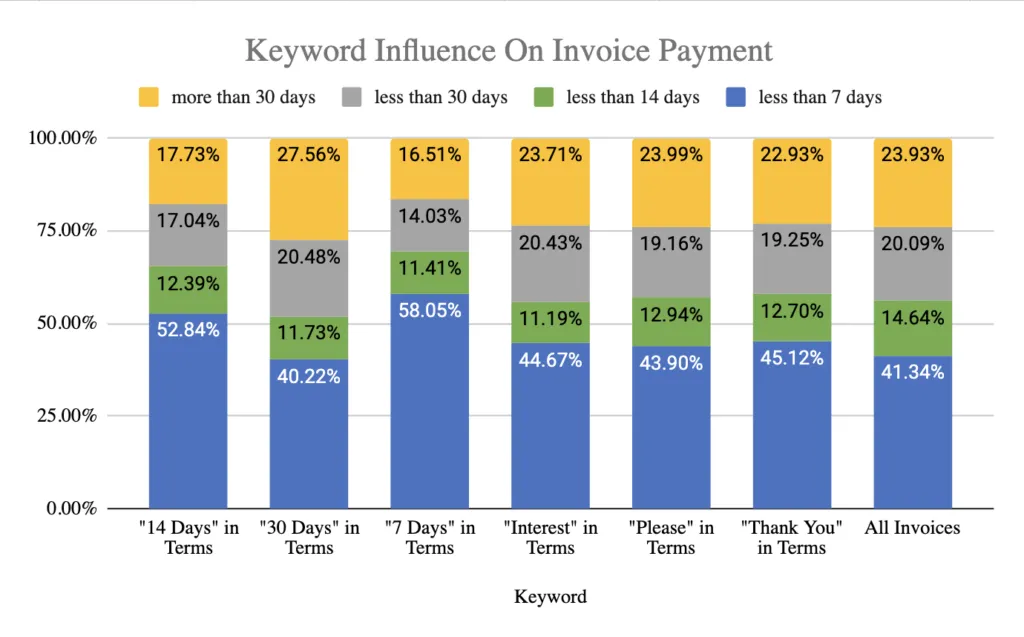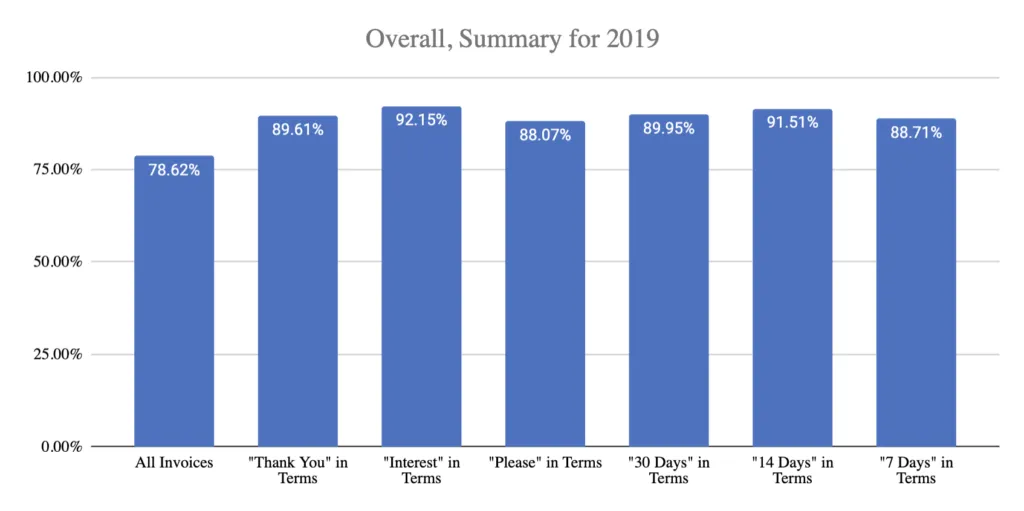Your invoice payment terms have the power to affect when customers pay you and even reduce how many unpaid invoices you have.

As a small business owner or freelancer, you probably know that getting paid is one of the biggest challenges.
Maybe you have clients who constantly pay late, or you’re always chasing them for payment. Perhaps you even have invoices you’re not sure you’ll ever see payment for.
We wanted to understand if there are any patterns to getting paid faster, so the FreshBooks Data Analytics team did some digging into what FreshBooks customers used as invoice payment terms in 2019, and how those terms affected client payments.
Ready to see the results? Drumroll please…
The above graph shows how the keywords (bottom axis) used in invoice payment terms affect how quickly customers pay (illustrated by color). On the right side is a column illustrating all invoices processed in FreshBooks, regardless of the keywords used in their invoice payment terms.
For example, 45.12% of invoices that use “Thank You” in the payment terms get paid in fewer than seven days with an additional 12.70% getting paid in fewer than 14 days.
Turns out if you give your clients more time to pay, they’ll take it: Putting “30 Days” in your payment terms has lower time-to-paid percentages than the “All Invoices” column.
One of the most glaring takeaways is that asking for payment sooner will get you paid sooner.
- It might seem obvious, but in 2019, 1,393,062 invoices were sent with “30 Days” in the invoice payment terms
- Of those invoices, only 40.22% got paid within seven days and a whopping 27.56% in 30+ days
- By comparison, the keyword “7 Days” leads to payment in fewer than seven days 58.05% of the time and in 30+ days only 16.51% of the time
For keywords that don’t specify days (Interest, Please and Thank You), there was also a slight increase in time-to-paid versus “All Invoices.” “Thank You” led the pack, resulting in invoices paid within seven days 45.12% of the time.
This next graph illustrates which keywords actually get customers to pay invoices. Using the keyword “Interest” in payment terms led to full invoice payment 92.15% of the time, followed closely by “14 Days” at 91.51%. By comparison, of all invoices sent in 2019, only 78.61% were actually paid—looks like including any of these payment terms can help get you paid.
Your key takeaway for being paid faster is to ask for payment within seven days and start charging interest on unpaid invoices. Throw in a “Thank You” and you’ve got your bases (and your client relationships) covered!
Wait … What Are Invoice Payment Terms Anyway?
Before you rush to update your invoice payment terms there are a few things you should know.
Invoice terms are typically located at the bottom of an invoice. They provide details including:
- How quickly you expect payment for services
- If there are interest charges for late payment
- What payment methods are accepted
Payment terms also give small businesses better control over their cash flow because they help customers understand how to process invoices.
While there are many options as to which phrases to include in your terms for payment, some phrases aren’t easily understood by everyone.
Terms like “10 net 30” and “CIA” might make sense to you, but if your clients are thinking “Central Intelligence Agency” instead of “Cash in Advance,” they might not pay on time.
Our advice: Short, straightforward and polite wins.
Here’s a handy list of terms and acronyms to give you a sense of what you might include in your payment terms:
| Net monthly account | Payment due on last day of the month following the one in which the invoice is dated |
| Upon receipt | Payment is expected immediately when the invoice is received |
| Net 7, 21, 30, 60, etc. | Payment 7, 21, 30, 60, etc. days after the invoice date |
| EOM | End of month |
| 21 MFI | 21st of the month following invoice date |
| 1% 10 Net 30 | 1% discount if payment received within 10 days, otherwise payment is due 30 days after the invoice date |
| COD | Cash on delivery |
| Cash account | Account conducted on a cash basis, no credit |
| Letter of credit | A documentary credit confirmed by a bank, often used for export |
| Bill of exchange | A promise to pay at a later date, usually supported by a bank |
| CND | Cash next delivery |
| CBS | Cash before shipment |
| CIA | Cash in advance |
| PIA | Payment in advance |
| CWO | Cash with order |
| 1MD | Monthly credit payment of a full month’s supply |
| 2MD | As above plus an extra calendar month |
| Contra | Payment from the customer offset against the value of supplies purchased from the customer |
| Stage payment | Payment of agreed amounts at stage |
Payment Terms on Your Terms
A line at the bottom of an invoice is easy to skim over and ignore, but it’s definitely something you’ll want to reference if a client doesn’t pay on time, or at all.
Invoice payment terms are there to help get you paid on terms that you and your clients have agreed to. Here’s what they do for you:
Control When You Get Paid
It might seem obvious, but it’s worth stating: Payment terms literally tell your clients when to pay you. So when negotiating contracts with clients, be sure to discuss your payment terms. Remember, this is a contract to protect your business. As a starting point, write invoice payment terms that serve you well and then negotiate from there.
Ideally, your payment terms should strike a balance between maximizing how quickly you get paid and avoiding inconvenience for your clients. Remember, while getting paid is the primary goal, you still want to foster healthy, long-term client relationships. However, don’t make their business challenges (cash flow or debt) your problem.
And don’t forget about the research above. If you’ve got clients that have no problem paying in seven days, then ask them to. If you don’t ask, they might just assume 30 days is fine and you’ll end up waiting for payment longer than you have to.
Remember that if your client has several invoices to pay and not enough funds, they’ll likely prioritize the ones that are due sooner and/or that have interest tied to them.
Control How You Get Paid
You should definitely have a say in how customers pay for your products and services, and including that in your payment terms is important.
When defining acceptable methods in your payment terms, make it as convenient as possible for your clients. There are many variables to consider depending on how many payments you process each month, but overall, letting clients pay their preferred way gets you paid faster.
If you’re used to taking checks and cash, consider switching to online or credit card payments. This will increase the likelihood of clients paying on time. One of the most progressive payment methods you’ll want to consider is allowing customers to pay with credit cards or bank transfers directly on invoices.
Make Payment Terms Part of Your Contract
It’s important to negotiate your payment terms before you begin work with any client. Most clients are reasonable and open to having a conversation about your expectations, and theirs. Once payment terms are agreed upon, be sure to outline them in your client contract in addition to your invoice.
With your payment terms appearing on both your invoices and client contract, you have legal standing if your client doesn’t pay an invoice when payment is due. You don’t necessarily need to run to court every time payments are a few days late, but it might be something to consider if follow-up emails and phone calls are ignored.
Predicting Payment Means Healthier Cash Flow
One of the biggest challenges of any small business owner or freelancer is getting paid. And while tools like online payments can speed up the turnaround of an invoice, setting terms of payment can also help you predict cash flow.
For example, if you invoice a client for $2,000 to pay in Net 7 (seven days from the invoice date), and they typically pay on time, then you can expect to have $2,000 of liquidity in seven days. Knowing how much money you have coming in makes it much easier to budget appropriately.
So, When Should Invoices Be Due?
In short, net 30 was historically used as the gold standard for payment because the end of each month was when businesses would have their monthly check runs. Some industries still hold true to this tradition, while others have modified and standardized the payment turnaround time across their industry. Simply put, there will always be instances where you’ll have to fall in line with how things are done elsewhere.
Otherwise, take complete control over the due date and any other payment term on your invoices. Other things to consider as a small business owner when setting payment terms are a customer’s payment history, the invoice amount, and the methods of payment you accept.
If you have a client who habitually ignores your net 30 payment term and pays 40 days after the invoice date, then shortening your due date to 15 days might persuade them to pay within 30 days. However, the amount on an invoice might also make it difficult for some business owners to pay in net 7 or even net 30. It might take time for some businesses to free up cash if your invoice is a sizable amount.
One thing you should also consider when deciding on any payment term is what methods of payment you accept. Typically credit cards and bank payments are safe and quick ways to pay an invoice, but if your client is out of the country they might have to wire money to you.
International money transfers can often take several days and can even have holds placed on them depending on the countries and banks involved in the transactions. If you know how your clients are paying you, then you can adjust the invoice due dates accordingly.
Improving Your Invoice Payment Terms
You might look at your existing invoice payment terms and think you have everything covered, but revisiting them for each new client or at regular intervals doesn’t hurt. As your business changes, they might need an update. Here are some things to consider:
Keep Them Short and Concise
If you want a client to pay an invoice in 30 days put “net 30” or “due 30 days upon receipt.” Keeping your terms short, clear and to the point ensures there’s no miscommunication.
Say Please and Thank You
Literally, type out please and thank you at the bottom of your invoices. As shown in our research, 89.61% of invoices are paid when they include the term “Thank You,” while 88.07% of invoices are paid when they include the term “Please.” Being polite in your invoice payment terms gets you paid faster.
Be Realistic and Flexible
Understanding that your clients are also business owners can help you create invoice payment terms that suit your needs and don’t put unnecessary pressure on them. Not every business has a healthy enough stream of cash to process invoices seven days after receiving them, or has the margins to handle a 20% interest penalty for late payment. Open communication with your clients is the best way to support the agreed-upon terms on your invoices.
Late Fees
As shown in our research, including a late fee or interest penalty term is one of the best ways to compel clients to pay: 92.15% of invoices are paid when they include the term “Interest” in the invoice payment terms.
Your Key Takeaway
As mentioned, asking for payment within seven days, and charging interest on late or unpaid invoices will get you paid faster and more often.
But, above all else, talk to your clients about your invoice payment terms in advance of doing any work for them. Open communication about your expectations and theirs is a great way to avoid confusion.
Then, once work starts and invoices are sent, you can always reference both your payment terms and your initial discussion about due dates, interest, methods of payment, etc. if you ever need to. Happy invoicing!
Wondering what the most polite state in the United States is? Read this article for the winners and losers.
This post was updated in July 2020.









![12 Silly Invoicing Mistakes That a Cloud Accounting Solution Will Save You From Making [Infographic]](https://www.freshbooks.com/blog/wp-content/uploads/2017/11/invoicing-mistakes-1-226x150.jpg.optimal.jpg)


